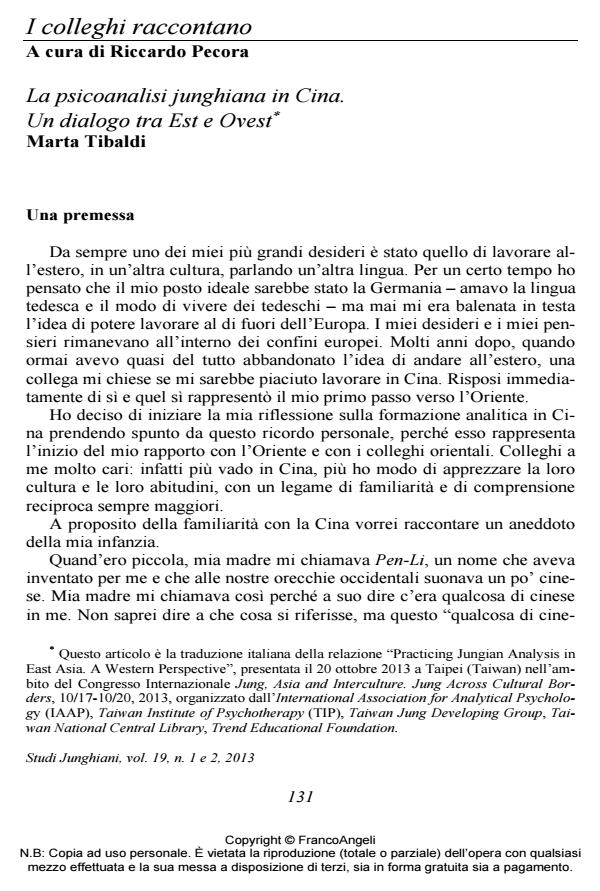Jungian psychoanalysis in Cina. A Dialogue between East and West
Journal title STUDI JUNGHIANI
Author/s Marta Tibaldi
Publishing Year 2014 Issue 2013/37-38 Language Italian
Pages 13 P. 131-143 File size 745 KB
DOI 10.3280/JUN2013-037009
DOI is like a bar code for intellectual property: to have more infomation
click here
Below, you can see the article first page
If you want to buy this article in PDF format, you can do it, following the instructions to buy download credits

FrancoAngeli is member of Publishers International Linking Association, Inc (PILA), a not-for-profit association which run the CrossRef service enabling links to and from online scholarly content.
Practicing Jungian psychoanalysis in China is a challenge for Western psychoanalysts from many viewpoints. This paper aims to reflect on three of them: the unconscious images of "Chinese" and "Western" inside ourselves; English as a working and a bridge-language between West and East; the interweaving of cultural and archetypal aspects in Chinese patients and the quest for transcultural words in order to tell their stories. Practicing Jungian psychoanalysis in China requires Western psychologists to empty their mind of any preconceptions and prejudices and to approach Chinese culture in a cultural respectful way, modifying, if necessary, Western analytical tools.
Keywords: China, psychoanalysis, analytical psychology, psychoanalytical training in China, East-West Dialogue
- Bollas C. (2013). China on the Mind. Hove, East Sussex: Routledge (trad. it. La mente orientale. Psicoanalisi e Cina, Milano: R. Cortina, 2013).
- Chuang Tzu (2012). Zuangzhi. Milano: Urra.
- Freud S. (1983-1985). Studies on Hysteria (trad. it. Studi sull’isteria. In: Opere, vol. 1. Torino: Boringhieri, 1967).
- Hillman J. (1983). Healing Fiction. New York: Station Hill Press (trad. it. Le storie che curano. Milano: R. Cortina, 1984).
- Jullien F. (2000). Detour and Access Strategies of Meaning in China and Greece. New York: Zone Books (trad. it. L’ansa e l’accesso. Strategie di senso in Cina, Grecia. Milano-Udine: Mimesis, 2011).
- Jung C.G. (2009). The Red Book. Liber Novus. A Reader’s edition. New York: Norton Company (trad. it. Il Libro Rosso. Liber Novus. Torino: Bollati Boringhieri, 2010).
- Jung C.G. (1955). Memories, Dreams and Reflections. London: Fontana Press (trad. it. Ricordi, sogni, riflessioni di C.G. Jung. Milano: Rizzoli, 1961).
- Kugler P. (1982). The Alchemy of Discourse. An Archetypal Approach to Language. New York: Associated University Press (trad. it. L’alchimia delle parole. Un approccio archetipico al linguaggio. Bergamo: Moretti e Vitali, 2002).
- Lao Tzu (1993). Tao Te Ching, ed. by S. Addis, S. Lombardo, B. Watson). Boston: Shambala Publications (trad. it. Tao Te Ching. Milano: Feltrinelli, 2011).
- Rimbaud A. (1873). Une Saison en Enfer. Bruxelles: Alliance typographique (edizione originale).
- Ronchey S. (2011). Addio a Hillman, cosi si muore da filosofo antico. La Stampa, 10 Ottobre.
- Shamdasani S., a cura di (2009). Liber Novus. The Red Book of C.G. Jung. New York: Norton Company (trad. it. Liber Novus. Il “Libro Rosso” di C.G. Jung. Torino: Bollati Boringhieri: 2010).
- Solms M., Turnbull O. (2002), The Brain and the Inner World. New York: Other Press (trad. it. Il cervello e il mondo interno. Milano: R. Cortina, 2004).
- Stroppa C. (2013). Fantasmi all’opera. L’imperiosa realtà dell’illusione. Bergamo: Moretti e Vitali.
- Tibaldi M. (1995). Psicologia analitica, esperienza della scrittura e conoscenza di sé. Rivista di Psicologia Analitica, 52: 19-31. Tibaldi M. (2004a). Le parole che curano: il potere archetipico del linguaggio. In: Mondo R., Turinese L., a cura di, Caro Hillman… venticinque scambi epistolari con James Hillman. Torino: Boringhieri.
- Tibaldi M. (2004b). Doppia oggettivazione e formazione dell’Io immaginale. In: Cerbo G.M., Palliccia D., Sassone A.M., a cura di, Alchimie della formazione analitica. Milano: Vivarium.
- Tibaldi M. (2013a). Hong Kong Seminars: Personal and Impersonal. Individual and Archetypal Experience in Clinical Practice. Part I and II, Aprile 2013, non pubblicato.
- Tibaldi M. (2013b). Hong Kong Seminars: Personal Impersonal Deep Writing (PIDW), Ottobre 2013, non pubblicato.
- Tibaldi M. (2013c). Deep Writing: Dealing Creatively with the Unconscious, Ottobre 2013, Taipei (Taiwan), non pubblicato.
- Tibaldi M. (2011). Pratica dell’immaginazione attiva. Dialogare con l’inconscio e vivere meglio. Roma: La Lepre.
- Tibaldi M. (2014). Practicing images. Clinical Implication of James Hillman’s Theory in a Multicultural Reality and in a Changing World. In: Hiskinson L. and Stein M., eds, Analytical Psychology in a Changin World: the Search for Self, Identity and Community). London: Rutledgeuscita il 29 settembre 2014).
- Wenzhong H., Grove C.N., Enping Z. (2010). Encountering the Chinese. A Modern Country, an Ancient Culture. London: Intercultural Press.
- Wilhelm R. (1971). Das Geheimnis der Goldenen Bluete: Ein chinesisches Lebensbuch. Olten u. Freiburg: Walter Verlag (trad. it. Il segreto del fiore d’oro. Torino: Boringhieri, 1981).
- Wilhelm R. (1981). The Secret of the Golden Flower. A Chinese Book of Life. San Diego, New York, London: Harvest Book (trad. it. Il segreto del fiore d’oro, Torino: Boringhieri, 1981).
Marta Tibaldi, La psicoanalisi junghiana in Cina. Un dialogo tra Est e Ovest in "STUDI JUNGHIANI" 37-38/2013, pp 131-143, DOI: 10.3280/JUN2013-037009